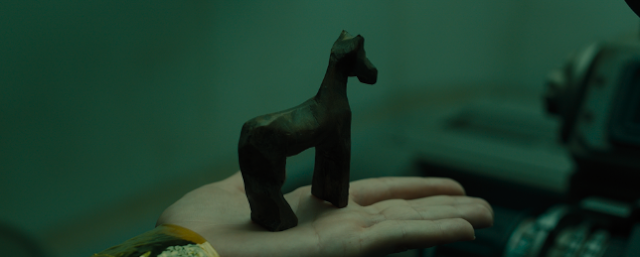The memory in question is a vivid recollection of a child hiding a carved wooden horse in an abandoned building, marking the location with a date. This memory is significant because it suggests a personal history and emotional experiences, elements that are not expected to be part of a replicant's life, as replicants are bioengineered beings created by humans.
In the universe of "Blade Runner," memories are manufactured and can be implanted into replicants to provide them with a backstory, making them more stable and less likely to question their existence or rebel against their human creators. The memory of the wooden horse, however, stands out because it is not just any memory; it is one that is deeply personal and emotionally resonant, suggesting a lived experience rather than a fabricated one.
K thus begins to question his true identity.
As Agent K investigates the origins of this memory, he discovers that it belongs to Dr. Ana Stelline, a character who specializes in creating artificial memories for replicants. She confirms that the memory is indeed real, a revelation that initially leads K to believe he might be the child in the memory, potentially making him a replicant born from a replicant, a groundbreaking anomaly that challenges the established understanding of replicant biology and their societal role.
However, the narrative later reveals that this memory, while genuine, was not K's own but was implanted in him. Dr. Stelline, the true child in the memory, had incorporated her own experiences into the memories she crafted for others. This decision to include a piece of her reality in the artificial memories she created for replicants like K adds layers of complexity to the themes of identity and reality explored in the film.
As Agent K investigates the origins of this memory, he discovers that it belongs to Dr. Ana Stelline, a character who specializes in creating artificial memories for replicants. She confirms that the memory is indeed real, a revelation that initially leads K to believe he might be the child in the memory, potentially making him a replicant born from a replicant, a groundbreaking anomaly that challenges the established understanding of replicant biology and their societal role.
However, the narrative later reveals that this memory, while genuine, was not K's own but was implanted in him. Dr. Stelline, the true child in the memory, had incorporated her own experiences into the memories she crafted for others. This decision to include a piece of her reality in the artificial memories she created for replicants like K adds layers of complexity to the themes of identity and reality explored in the film.
It raises questions about what constitutes individuality and the nature of memories in shaping who we are, whether we are human or replicant.
The inclusion of the horse memory in Agent K's memories serves multiple narrative purposes:
The inclusion of the horse memory in Agent K's memories serves multiple narrative purposes:
- It drives the plot by leading K on a quest for his origins and the truth about his existence.
- It blurs the lines between humans and replicants, suggesting that the capacity for emotional experiences and personal memories might not be exclusive to humans.
- It explores the ethical implications of memory manipulation and the creation of artificial beings with emotional depth.
















0 comments:
Post a Comment